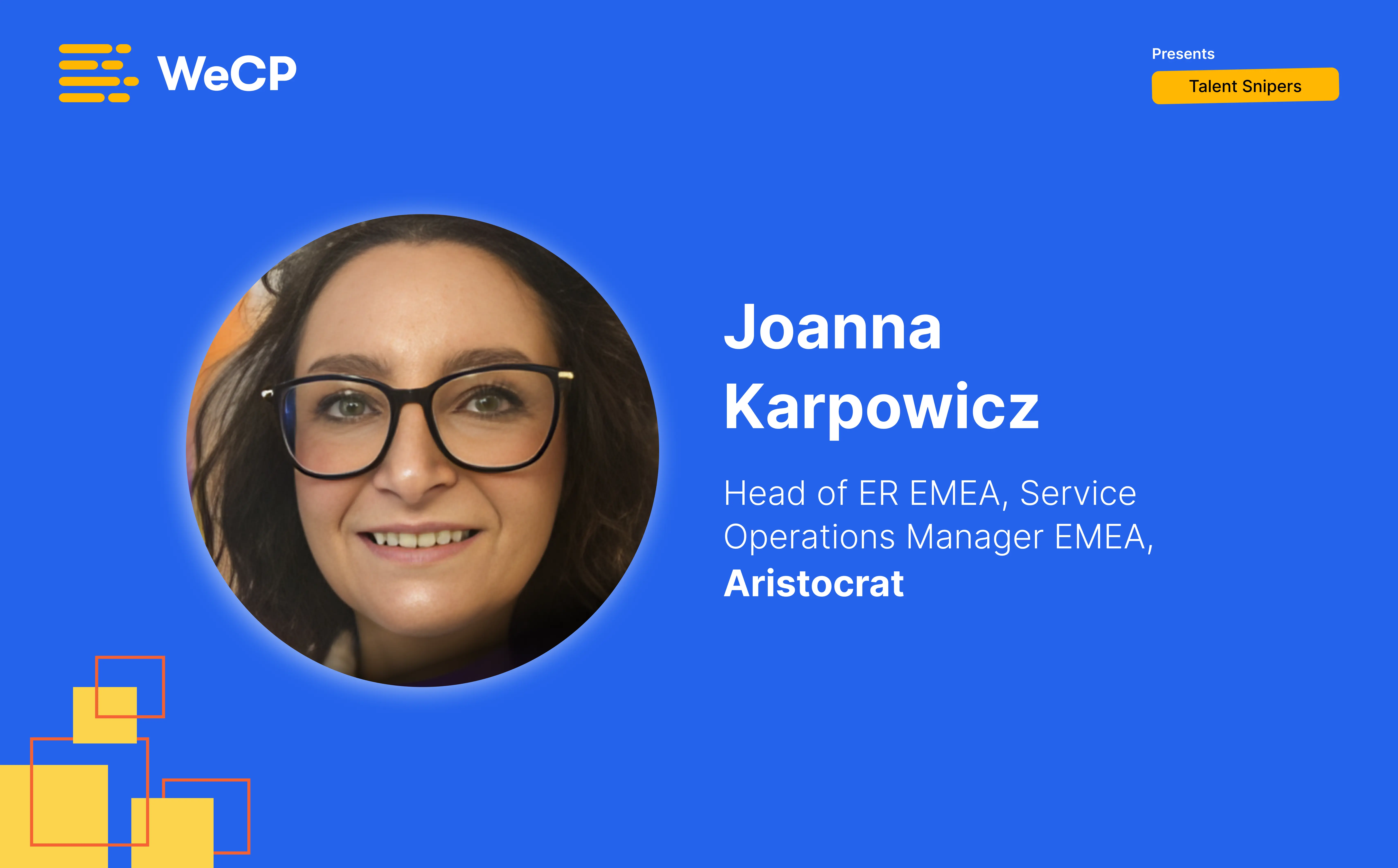
Employee engagement isn’t just a corporate buzzword—it’s the foundation of a thriving, people-first workplace. Organizations that prioritize inclusion and strategic engagement don’t just retain talent; they create cultures where employees feel valued, empowered, and driven to contribute their best.
This is an interview series where we talk to HR professionals, business leaders, and influencers about the evolving dynamics of workplace culture, employee engagement, and leadership.
In this edition, we speak with Joanna Karpowicz, Head of ER EMEA, Service Operations Manager EMEA at Aristocrat. With a career shaped by experience at organisations such as Citi, J. P. Morgan, Primark Stores Limited; she shares key insights on fostering an inclusive, engaged workforce—backed by real-world experience and actionable strategies.
I knew from the very start of my bachelor’s degree that HR was where I wanted to build my career. Every step I’ve taken since has been a deliberate move toward that goal.
My journey took me to Ireland, where I earned my HRM degree from a DCU, gaining an invaluable international perspective. Each role I’ve taken has been a strategic step up, expanding my expertise across HR operations, employee relations, and organizational change.
Today, as a Service Operations Manager & ER Head for EMEA, I thrive on leading regional teams, solving complex HR challenges, and shaping strategies that create lasting impact. HR isn’t just my profession—it’s my passion, and I’m excited to keep growing, learning, and making a difference.
One motto I live by in my work is:
"Clarity creates confidence."
In Employee Relations and Service Operations, ambiguity can lead to confusion, inefficiency, and unnecessary tension. I’ve learned that clear communication, consistent processes, and collaborative problem-solving create a foundation of trust and efficiency.
This principle has shaped how I lead teams, handle complex ER cases, and drive operational excellence across EMEA markets. Whether it's guiding employees through challenging situations, integrating teams post-acquisition, or optimizing service delivery, I always strive to simplify the complex, provide clear direction, and ensure alignment.
At the end of the day, clarity fosters confidence—not just in processes, but in people. And that’s what truly drives impact.
There was a moment in my career that changed how I saw HR forever. One of my employees passed away—alone—and it was my team, our HR team, who found him.
I never thought something like that would be part of my role. We talk about HR in terms of strategy, compliance, and operations, but at its core, it’s about people—their lives, their struggles, their well-being. This experience made me realize that HR isn’t just about managing people; it’s about truly being there for them in ways we don’t always expect.
Since that day, I’ve carried this perspective forward.
"Every case, every policy, every decision—it’s about the people behind it. Because at the end of the day, that’s what matters most."
Over the years, I’ve learned that employee engagement and inclusion aren’t just buzzwords—they’re the foundation of a thriving workplace. Here are a few strategies I’ve used to build engaged, inclusive, and connected teams:
At the core, engagement and inclusion start with leadership—not just what we say, but how we show up, listen, and lead by example.
Building a strategic employee engagement plan isn’t just about rolling out initiatives—it’s about understanding what truly drives people. Throughout my career, I’ve come across several challenges when designing engagement strategies, and here’s what I’ve learned works best:
What Worked for Me: I’ve seen firsthand that what engages one team may not work for another. To bridge this gap, I’ve focused on localized feedback, making sure that engagement plans reflect the cultural and operational realities of different teams. Regular check-ins, listening sessions, and tailored action plans have been key.
What Worked for Me: Engagement thrives when leaders actively participate. I’ve found that showing leadership clear data on engagement’s impact—retention, productivity, business results—helps secure their buy-in. When leaders are visible in engagement efforts, it shifts from an HR initiative to a business priority.
What Worked for Me: Engagement isn’t just about surveys—it’s about real behavioral change. I’ve learned that tracking key data points like attrition rates, internal mobility, and employee sentiment over time paints a clearer picture of engagement effectiveness than relying solely on survey scores.
"Engagement without inclusivity is superficial—people can’t be truly engaged if they don’t feel seen, heard, or valued."
What Worked for Me: Prioritizing inclusivity by:
The Bottom Line
Engagement only works when it’s personal, intentional, and measurable. By focusing on tailored strategies, leadership involvement, meaningful metrics, and inclusivity, I’ve seen teams become more connected, motivated, and high-performing.
If I could implement one transformative change in HR, it would be embedding employee relations and service operations as proactive, strategic business functions rather than reactive support roles.
HR is often seen as the department that steps in when things go wrong—handling disputes, compliance issues, and administrative processes. But in reality, HR has the power to shape an organization’s culture, drive engagement, and future-proof businesses.
HR would no longer be the department of policies and paperwork—it would be the strategic backbone of every successful organization. This shift would drive stronger cultures, higher engagement, better retention, and a more future-ready workforce.
One insight I’ve learned—something that rarely makes it into leadership training programs—is this:
"Your ability to navigate uncertainty and discomfort will define your success more than any process, strategy, or framework."
Textbooks teach models, policies, and best practices, but they don’t prepare you for the grey areas—the moments when there’s no perfect answer, just the best decision you can make with the information at hand.
I’ve had to:
Staying adaptable, embracing discomfort, and trusting in my ability to figure it out. Leadership isn’t about knowing all the answers—it’s about having the confidence to navigate the unknown, bring people along with you, and learn as you go.
Thanks Joanna! Some great insights in there! If you liked reading this post, you can follow Joanna Karpowicz on her LinkedIn!